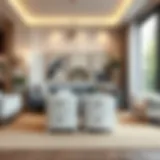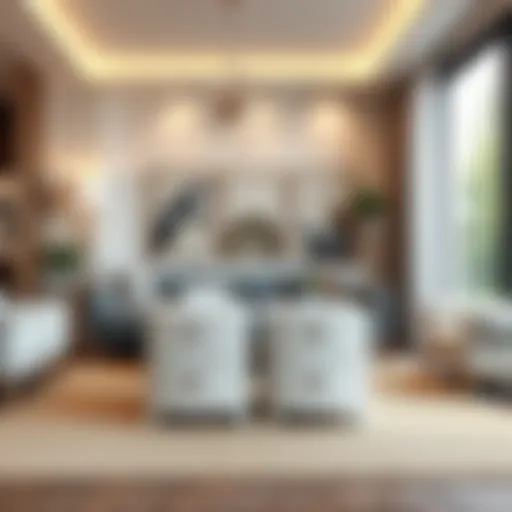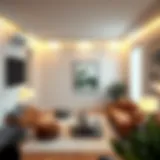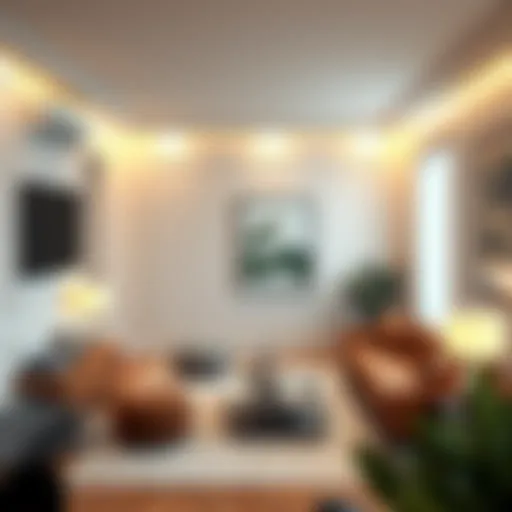Elevate Your Kitchen with Pendant Lighting Solutions
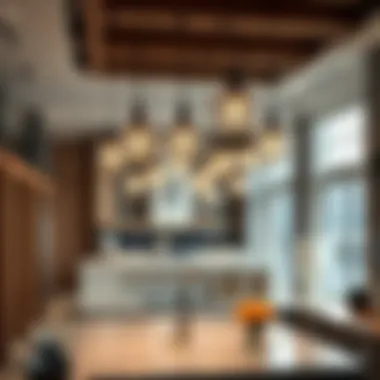

Intro
When it comes to kitchen design, lighting isn’t just a practical consideration; it plays a pivotal role in shaping the mood and functionality of the space. Among the various lighting options available, pendant lighting stands out for its versatility and aesthetic appeal. These fixtures can transform a mundane kitchen into a stylish culinary haven. In this guide, we will explore the intricacies of kitchen pendant lighting, focusing on its design trends, placement strategies, and functional benefits.
Smartly selected pendant lights can accentuate your kitchen's character. Whether you're aiming for a rustic farmhouse vibe or a sleek modern look, the right lighting can make all the difference. Not only do pendants provide essential illumination, but they also act as striking decor elements that can tie your kitchen design together.
As we dive deeper into this topic, you'll discover insights that cater to both function and fashion. This comprehensive guide is geared towards homeowners, interior decorators, and DIY enthusiasts looking to enhance their kitchen spaces. From current trends to practical tips, we're set to unlock the potential of your kitchen lighting.
Prelims to Kitchen Pendant Lighting
When one thinks of kitchen lighting, the usual suspects might pop up first—overhead fixtures, recessed lights, or maybe even a spotlight or two. However, kitchen pendant lighting has emerged as a centerpiece that marries both style and function. Having pendant lights can create an inviting ambiance while also illuminating essential workspaces.
Beyond mere aesthetics, pendant lights can serve various practical purposes. They can delineate spaces, such as separating an island from the rest of the kitchen, while adding a design element that can reflect your personal style. For homeowners, designers, and DIY enthusiasts alike, understanding the nuances of kitchen pendant lighting can elevate a standard kitchen into a memorable space.
Consider the multiple benefits that come with incorporating pendant lighting into your kitchen:
- Versatility: They come in various styles, sizes, and colors, making them suitable for any kitchen theme. A vintage brass pendant might nestle well in a farmhouse setting, while sleek glass or metal fixtures could suit modern or minimalist designs.
- Functionality: Pendants are not merely decorative; they provide focused light where it’s most needed, like above countertops or islands. This can enhance cooking or other tasks requiring attention to detail.
- Layering Light: Kitchen design is all about layering—different sources of lighting create depth and mood. Pendant lights can be an integral part of that layering, used in conjunction with other light types to achieve a balanced brightness.
However, several considerations should be made when selecting pendants. Height from the ceiling and distance from surfaces below are crucial for both form and function. Too low, and they block sightlines; too high, and they fail to provide adequate lighting.
Furthermore, recent trends have seen a surge in technology integration—smart lighting solutions are on the rise. These allow homeowners to control brightness or even color temperature via apps, merging technical convenience with thrilling design.
In summation, exploring kitchen pendant lighting is not just about stringing bulbs from the ceiling. It's about weaving a narrative through careful choices, enhancing the kitchen's role as the heart of the home. With an array of styles, functionalities, and modern innovations, kitchen pendant lighting can exceptionally complement any culinary space.
"Lighting can transform any room from mundane to magical, and pendant lights certainly play a starring role in that narrative."
For further insights on lighting effects and trends, check out Lighting Design Resources or Interior Design Tips.
The Importance of Lighting in Kitchen Design
When it comes to kitchen design, lighting often takes a backseat to other elements like cabinetry or countertop selection. However, neglecting lighting can lead to a functional and aesthetic mishmash. In truth, the right lighting serves as the unsung hero of kitchen spaces. It balances visual appeal with practicality, ensuring that the culinary environment is both welcoming and efficient.
Good lighting does more than just illuminate; it's about crafting an experience. Think of the kitchen as a stage, where lighting sets the mood and highlights the performance of culinary activities. Properly placed kitchen pendant lights not only enhance the appearance of the space but also enable homeowners to engage more fully in food preparation, family gatherings, and even impromptu celebrations.
Creating Atmosphere
Creating the right atmosphere can transform your kitchen into a haven where memories are made. Imagine cooking dinner while basking in a warm, inviting glow. Pendant lights can help establish this ambiance, guiding social interactions and family connections. For instance, pendant lights with soft, diffused shades create a relaxed atmosphere, perfect for unwinding after a long day or having a heart-to-heart with a friend over a cup of coffee.
Different types of kitchen pendant lighting can cater to varying moods. Funky and colorful designs infuse energy, while more subdued options can invoke a sense of calm. Using dimmers can also play a significant role, allowing homeowners to adjust the brightness according to the occasion, whether it's an intimate dinner or an energetic brunch with friends.
"Lighting enables the sense of sight, but it also taps into the emotional aspect of our experiences. A well-lit space not only shows your home; it tells its story."
Enhancing Functionality
While atmosphere is vital, the functionality of lighting in the kitchen should never be overlooked. High-quality kitchen pendant lights not only add aesthetic value but also provide essential task lighting. Consider, for example, the act of chopping vegetables. The right lighting can eliminate shadows, making the task safer and more efficient. Pendant lights strategically hung above countertops and islands light the workspace, allowing for precision and accuracy in food preparation.
Moreover, the angle and intensity of the light can often determine how well you see colors and textures in your ingredients. This is especially crucial for those who take pride in cooking or baking, as it can impact the outcome of their culinary creations. To truly capitalize on the functional aspects of lighting, layering different types of lighting—ambient, task, and accent—can create a well-rounded approach.
- Ambient Lighting: The overall lighting of the kitchen, setting the stage.
- Task Lighting: Focused and brighter lights over work areas.
- Accent Lighting: Adds charm and highlights architectural features or design elements.
In summary, prioritizing the importance of lighting enhances both the atmosphere and functionality of the kitchen. When thoughtfully integrated, kitchen pendant lighting can elevate a house, turning a simple culinary space into a vibrant heart of the home.
Diverse Styles of Kitchen Pendant Lighting
When it comes to the realm of kitchen pendant lighting, the array of styles available is as diverse as the homes they illuminate. Understanding the variety of options is fundamental for anyone looking to enhance their kitchen’s character. Each style not only serves a functional purpose but also communicates a distinct aesthetic and atmosphere within the culinary space. Whether you lean toward modern elegance, rustic charm, or an industrial edge, your choice can significantly influence the kitchen’s overall vibe. Here, we’ll dive into specific styles, shining a light on their unique attributes, benefits, and considerations.
Modern Aesthetics
Modern kitchen pendant lights often exhibit clean lines, geometric shapes, and minimalistic designs. They typically feature materials like glass and metal, embodying simplicity while making a statement. These fixtures create an airy, uncluttered feel, aligning perfectly with contemporary design philosophies that emphasize functionality and stylishness.
For instance, an oversized pendant light with a sleek, bulbous shape can become the focal point of an otherwise understated kitchen. Additionally, materials such as brushed nickel or polished copper are often employed, adding a touch of sophistication. It’s imperative to consider that while modern styles can illuminate beautifully, they should be in harmony with other elements in the kitchen to avoid a mismatched appearance.
Rustic Charm
Rustic kitchen pendant lighting brings a warm, inviting feel, evoking the essence of countryside life. Often crafted from materials like reclaimed wood, wrought iron, or even mason jars, these fixtures add texture and a sense of history to the kitchen environment. They work well in homes designed with a farmhouse aesthetic or even in eclectic environments where vintage elements coexist.
A beautiful example of this style might be a cluster of pendant lights made from aged metals hanging over a wooden island. Such selections can evoke comfort and familiarity, making the kitchen not just a place for cooking but a welcoming space for gatherings and family dinners. However, it’s essential to balance these rustic touches with modern appliances and other contemporary elements to maintain a cohesive design.
Industrial Appeal
Industrial pendant lighting thrives on rawness and boldness, often displaying exposed bulbs and unfinished metals. Rooted in the aesthetics of factory and warehouse spaces, these fixtures exemplify rugged charm. They can add a striking contrast within more refined kitchens or seamlessly fit into homes where urban styles predominate.
Consider hanging a series of matte black or brushed steel pendant lights in a kitchen dotted with visible ductwork. Their rugged robustness can ground the space while enhancing its industrial theme. Given their impactful presence, these lights should be chosen carefully, ensuring they don’t overwhelm the kitchen’s décor.
Classic and Vintage Designs
Classic and vintage pendant lights often remind us of traditional craftsmanship and timeless elegance. With intricate details, these fixtures may feature antique finishes, ornate designs, and classic silhouettes like globe or lantern shapes. They can transform a standard kitchen into a charming, nostalgic space, invoking feelings of nostalgia and warmth.
For example, imagine a vintage brass pendant light with etched glass illuminating a cozy dining nook. Such pieces not only add character but can serve as historical conversation starters when hosting guests. The challenge lies in ensuring that the vintage styles do not clash with modern furnishings, preserving the timeless elegance that characterizes this choice.
Contemporary Innovations
The evolution of kitchen pendant lighting has birthed innovative designs that play with technology and sustainability. LED fixtures, for instance, not only offer energy efficiency but also come in an array of modern shapes and effects. Some contemporary pendants incorporate smart technology, allowing homeowners to adjust brightness and color with ease.
Picture a sleek, dimmable pendant light that can shift from bright white for cooking to a softer hue for dining. This level of versatility empowers users to create personalized atmospheres tailored to different occasions, giving them control over their kitchen environment. However, as with any modern technology, it's crucial to ensure compatibility with existing home systems to avoid any operational hassles.
By understanding the various styles available in kitchen pendant lighting, homeowners can make informed decisions that not only serve their lighting needs but also elevate the overall aesthetic of their kitchens. Each style carries its unique characteristics and emotional resonance, ensuring that there’s something for everyone—whether they prefer the sleek lines of modernism or the warmth of rustic charm.
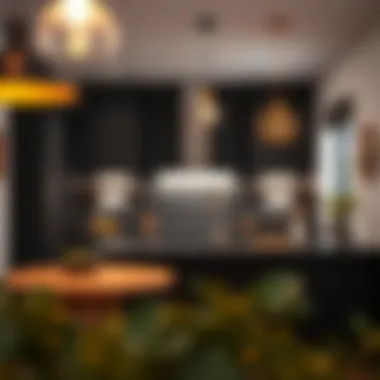
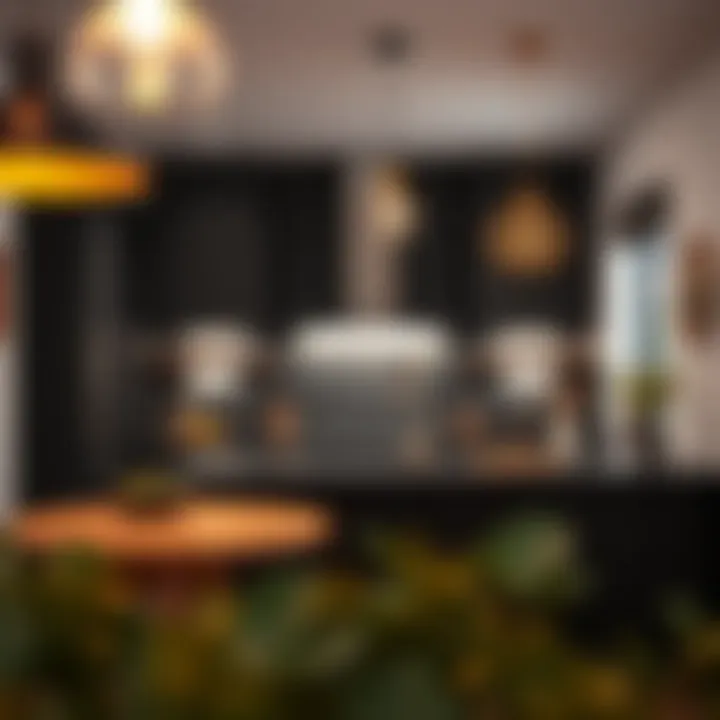
Materials Used in Pendant Lighting
Choosing the right materials for kitchen pendant lighting is not only about aesthetics; it also touches on functionality, durability, and overall ambiance. The materials used can dictate how well the light diffuses, how easy it is to clean, and even how it holds up against moisture and temperature fluctuations typical in kitchens. It's essential to think about how each material aligns with the kitchen's design and the practical needs of the space. Let's delve into some of the most common materials used in pendant lighting and explore their unique characteristics.
Glass
Glass is a pervasive choice for pendant lighting, thanks to its ability to create a bright and airy environment. The clarity of glass illuminates spaces efficiently while adding a sleek sophistication. From frosted to clear finishes, glass options offer a range of looks.
A significant benefit of glass pendants is their versatility. They can be fashioned into modern, classic, or artistic designs, making them suitable for any kitchen aesthetic. Moreover, cleaning glass is relatively straightforward; a simple wipe with glass cleaner usually does the trick. However, one should consider that glass can be fragile, so it necessitates careful installation and handling.
Metal
Metal pendant lights bring a robust and industrial vibe to kitchens, which can be quite appealing in contemporary settings. Common metals used include brass, copper, and stainless steel. Each metal offers distinct visual elements and finishes. For example, brass can deliver a warm touch while stainless steel tends to fit slick, modern designs.
Functionally, metal is durable and can endure the hustle of a kitchen environment without losing its charm. It’s worth noting though that metal fixtures may require more maintenance. They can tarnish or show fingerprints easily, so a little extra care is needed for keeping them looking their best.
Fabric and Other Textiles
Fabric shades on pendant lights may not be the first thing that comes to mind, yet they have their own charm, especially in creating a soft, inviting space. Textiles can diffuse light more gently, softening sharp shadows and casting a warm glow across the kitchen.
Common materials include linen and cotton, which can be especially welcoming in family-oriented spaces. However, one has to consider the practicality — fabric can stain and may not be as easy to clean as metal or glass. Regular upkeep and consideration of moisture levels in the kitchen are crucial to maintaining fabric fixtures.
Wood and Natural Materials
Wood is a fantastic option if you are aiming for a warm and rustic feel. Using reclaimed wood in pendant designs can add character and a story to your kitchen. Beyond aesthetics, wood is also believed to bring an element of nature indoors, which many find soothing.
When considering wood, factors like finish quality and whether it's treated for moisture resistance come into play. Natural materials like bamboo or rattan can offer similar benefits while lending a tropical flair. The key is to ensure that the natural materials are adequately finished to withstand the kitchen's environment while still adding that organic touch to your lighting scheme.
"Selecting the right material for pendant lighting significantly influences not just the look, but the overall performance in your kitchen space."
By understanding the unique properties of each material, homeowners, designers, and DIYers can make informed decisions tailored to their kitchen's specific needs. In combination with other design elements, selecting suitable materials will elevate the functionality and beauty of kitchen pendant lighting.
Optimal Placement of Pendant Lights
When diving into the practicalities of kitchen pendant lighting, optimal placement stands tall as a key consideration. The right positioning of your pendant lights can enhance not just the functionality but the entire ambiance of your kitchen. Think about how light interacts with every space: it can create soft shadows in one corner while illuminating another brightly. This balance is crucial, as light does more than just brighten a room—it defines its character.
Over Islands and Bars
Installing pendant lights directly above kitchen islands and bars can yield remarkable results. This area often serves multiple purposes, from casual breakfasts to intricate meal prep. By hanging pendant lights here, you draw attention to the island, essentially making it the heart of the kitchen. A general rule of thumb is to keep the bottom of the pendant light 30 to 36 inches above the counter. This ensures adequate lighting without obstructing views.
Moreover, choosing fixtures with varying heights can add visual intrigue. For instance, a staggered arrangement of pendants can transform a mundane island into an art piece. And if you go for a more open kitchen style, pendant lights can seamlessly connect your cooking space with dining or living areas, amplifying the flow of light and conversation.
In Dining Areas
In dining areas, pendant lights play a complimentary role. They can create an intimate setting, perfect for those long family dinners or friendly gatherings. When positioning these lights, consider hanging them above your table. The recommended height sits at about 28 to 34 inches above the table surface. This height ensures that your guests can enjoy their meals without being blinded by glaring bulbs.
Design plays a significant role here too. A large, bold pendant can serve as a statement piece, drawing focus to the dining space. Conversely, a line of smaller, understated lights can add elegance without overpowering the decor. Keep in mind that the color of the light can also set the mood, so think about dimmable options or warm tones to foster a cozy atmosphere.
Highlighting Workspaces
Every inch of the kitchen has its function, and workspaces deserve their own consideration when it comes to lighting. Whether it's directly above a cutting board or the sink, appropriate lighting can help prevent accidents and improve visibility. Pendant lights can do more than just look good in these areas; they can also enhance productivity.
Consider the alignment of light when placing pendants in workspaces. The light should ideally shine down directly onto the area without creating shadows. A good strategy is to install multiple smaller pendants or a linear light fixture to spread illumination evenly. Utilizing flexible, adjustable pendants can also allow you to direct light exactly where it's needed, making your workspace not just well lit but functional.
"The right light makes the kitchen the most welcoming space in the home."
With these considerations for optimal placements, you can create a workspace that not only shines but also feels inviting, ensuring that all who enter your kitchen feel at home.
For additional insights on kitchen lighting design, check resources like Wikipedia or explore practical tips from Reddit.
The significance of each placement cannot be overstated; the atmosphere of a room can pivot dramatically with a simple change in lighting style or positioning. So take your time, plan, and don’t hesitate to experiment with different setups.
Choosing the Right Size and Scale
Selecting the appropriate size and scale for your kitchen pendant lighting is pivotal to not only achieving an aesthetic balance but also enhancing the functionality of the space. The right-sized pendants can transform a kitchen into the heart of the home, while poorly chosen dimensions might create visual clutter or, on the flip side, vanish into the background. Getting it right fosters an atmosphere that feels both inviting and thoughtfully curated.
Proportions and Dimensions
When talking about proportions, it’s crucial to consider the dimensions of both the room and the fixtures themselves. A pendant light that’s too small can leave the space feeling empty, like a grand theater with no audience, while a light that's excessively large can seem to overshadow everything else. Here are some pointers:
- Room Size: For a standard kitchen island, the general guideline is that the diameter of the pendant should be about one-third the width of the island. This helps ensure a pleasing aesthetic without overwhelming it.
- Height Above Surfaces: As a rule of thumb, pendants should hang 30 to 36 inches above the countertop or dining surface. This height not only provides optimum lighting but also keeps the fixtures within the line of sight without creating obstructions.
- Multiple Fixtures: If you're hanging multiple pendants, spacing them evenly is vital. A good starting point is to place them approximately 24 to 30 inches apart, ensuring each one serves a purpose in illuminating the space collectively.
Balancing with Other Fixtures
Finding harmony between your pendant lights and other elements in the kitchen is essential. Balancing with other fixtures can prevent any one feature from stealing the show, resulting in a more cohesive look. Consider these aspects:
- Style Cohesion: Ensure that your pendants correlate in style with existing elements, such as cabinetry, countertops, and wall colors. For instance, a sleek, modern pendant might feel out of place in a rustic kitchen filled with wood textures.
- Layered Lighting: Kitchen lighting typically comprises a combination of task, ambient, and accent lighting. When selecting pendants, regard the size and intensity of these light sources. A large, bright pendant may necessitate softer light elsewhere to maintain balance.
- Color and Finish Coordination: The finish of your pendant lights should complement other hardware in the kitchen. Whether it’s brushed nickel, gold, or matte black, consistency in color tones across fixtures allows the eye to flow through the space.
Quote: "Great design is about balance and proportion, and when it relates to light fixtures, it’s even more vital to master these elements for a harmonious flow in your kitchen."
Color Temperature and Lighting Effects
In the realm of kitchen pendant lighting, the concept of color temperature plays a pivotal role. Understanding this aspect can fundamentally alter the aesthetics and function of your kitchen. Color temperature, measured in Kelvins (K), ranges from warm, yellowish tones to cool, bluish hues. The right balance can make a home feel inviting or sterile, depending on the effect you aim for.
Choosing the right color temperature enables you to enhance various kitchen activities. For instance, warmer light (around 2700K-3000K) creates a cozy ambiance, perfect for intimate gathered meals. Conversely, cooler light (above 4000K) is ideal for detailed tasks like cooking and food prep, as it mimics daylight and boosts visibility.
Moreover, the perception of space is altered by the color temperature. Soft, warm lights tend to make a room feel smaller and more intimate, while cool lights can open up a space, giving a more expansive feeling. Hence, when selecting pendant lighting, it’s crucial to consider the balance between aesthetic enjoyment and functional efficiency.
"The nuances of light can create an entirely different atmosphere in your kitchen that just might encourage you to whip up that gourmet meal you've been thinking about!"
Warm vs. Cool Lighting
Warm lighting typically ranges from 2700K to 3000K. It gives off a golden glow reminiscent of candlelight, making spaces feel intimate and welcoming. It's particularly advantageous in dining areas where meals are shared, as it enhances food presentation and contributes to a more relaxed dining experience. Characteristics include:
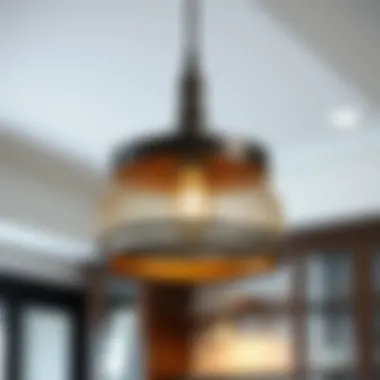
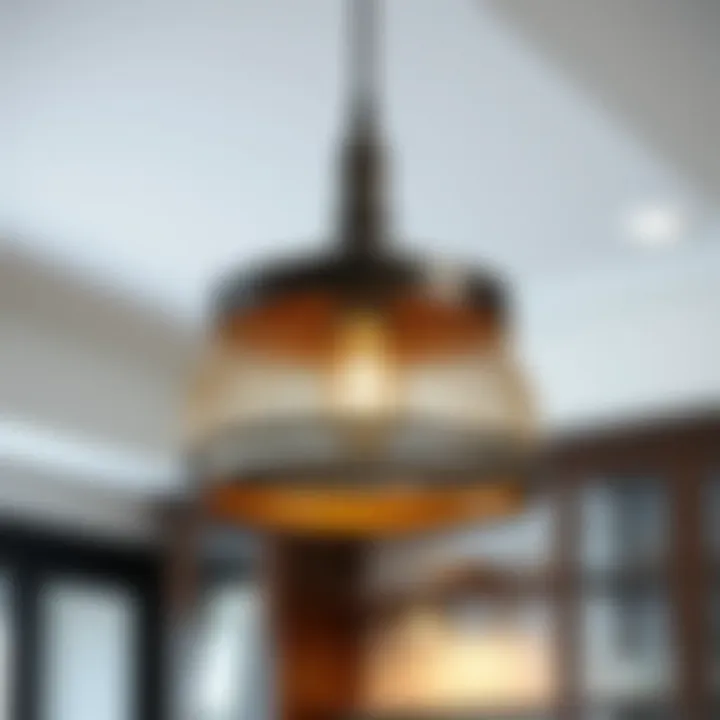
- Rich, inviting tones that foster conversation
- Ideal for relaxed family evenings or gatherings
- Pairs exceptionally well with wooden finishes and warm-colored palettes
However, in other spaces, especially where kitchen tasks take precedence, warm lighting can sometimes create shadows or reveal flaws in food preparation areas. Therefore, while it's great in moderation, be mindful of its application in active zones.
On the flip side, cool lighting, starting around 3500K and going up to 6500K, has a more clinical, bright white to bluish tint. This type of lighting simulates daylight and can be beneficial for various cooking activities:
- Provides clear visibility for food preparation and cooking
- Lessens eye strain when doing detail work
- Works well in conjunction with stainless steel and neutral colors
Creating Different Moods
The interplay of color temperature with lighting can efficiently sculpt the atmosphere of your kitchen. Want to spark creativity while whipping up a meal? Consider a cooler light setting. This promotes alertness and energy, making it more conducive to cooking.
A well-placed dimmer switch can help control this balance. It allows you to shift between settings; bright whites during bustling cooking spells and warm, inviting tones for winding down dinners. To further elevate the ambiance, consider layering lights:
- Combine pendant lights with under-cabinet lighting to maximize both functionality and atmosphere.
- Use accent lighting as focal points to draw attention to certain areas (perhaps a beautiful spice rack or an artistic backsplash).
Ultimately, harnessing the strengths of both warm and cool lighting can create a dynamic experience in your kitchen. A space designed with an eye for color temperature and the moods they curate can significantly enhance daily cooking and dining rituals.
For more detailed insights on color temperature, consider visiting resources like Wikipedia's Color Temperature or Britannica.
Exploring how lighting affects human mood is nothing new—research frequently links well-lit environments to increased productivity and improved well-being. With careful thought and design, your choice in kitchen pendant lighting can support both functionality and the kind of warmth that makes a house feel like home.
Installation Considerations
When it comes to kitchen pendant lighting, the devil is truly in the details. Installation considerations are not just technicality; they play a pivotal role in ensuring that your lighting enhances both the aesthetics and functionality of your kitchen space. A well-installed pendant light can accentuate the design elements of your kitchen while providing the needed illumination for tasks like cooking and entertaining. Failing to account for installation intricacies can lead to underwhelming results, potentially derailing your carefully planned kitchen environment.
Electrical Requirements
Getting the electrical aspects right is crucial. First off, you should consult a certified electrician, especially if you're not a seasoned DIYer. Ensuring your kitchen circuit can handle the load of your new fixtures is paramount. Here’s a checklist to consider:
- Voltage Requirements: Most pendant lights operate on 120 volts in the United States. Confirm that your kitchen's electrical framework is compatible.
- Wattage: Keep an eye on the total wattage of all fixtures on the same circuit to prevent overloading. A common household circuit can usually handle around 15 to 20 amps.
- Wiring: Make certain that the wiring in your kitchen is up to code. Outdated wiring can create safety hazards.
If you’re planning on installing dimmable lights, ensure your existing switch is also rated for dimmable circuits. Those who want to incorporate smart lighting will need to assess whether their current wiring can support advanced features like remote control functions. More crucially, this step helps prevent flickering, buzzing, or even worse, electrical fire.
Height Adjustments
The height of your pendant lights is equally important. Hanging lights too high may fail to provide the warm glow you desire, while those hung too low can obstruct views or create a cluttered feel. Here are some guidelines for getting it just right:
- General Rule of Thumb: A common recommendation is to hang pendant lights 30 to 36 inches above the countertop or dining surface. This height usually strikes a balance between functionality and style.
- Consider Ceiling Height: For kitchens with higher ceilings, you might consider hanging lights lower, especially if they're intended to illuminate a focal point like an island or bar. In contrast, lower ceilings require stricter compliance to minimum height guidelines to avoid accidents.
- Personal Preference: Ultimately, take into account your own tastes and the specific design of your kitchen. If you love the look of lower-hanging fixtures, go for it, but consider how it impacts your traffic patterns in the kitchen.
Remember, adjustments can often be made if your first installation doesn't suit your needs. Don't hesitate to re-evaluate the height after you live with the lighting for a bit. Lighting is not set in stone; it's a fluid element that can adapt as your needs change.
"Lighting should be flexible to match the mood of the kitchen – it’s not just about brightness; it’s about creating an experience." - An excerpt from kitchen design insights.
In summary, paying close attention to installation considerations can promote not just a beautifully lit kitchen but also a safe one. Whether it's understanding electrical needs or mastering the perfect height, these are the elements that will foster an inviting atmosphere. These strategic choices can elevate your kitchen design and ensure it serves as the heart of the home.
Maintenance and Care
In any design scenario, particularly within kitchens, maintenance and care hold a significant weight. Consequently, kitchen pendant lighting is no exception. When you invest your hard-earned money into quality lighting fixtures, you naturally want them to last. Proper maintenance ensures longevity, retains the aesthetic appeal, and maintains functionality. Ignoring these aspects can lead to unsightly build-up, potential malfunctions, and ultimately, extra expenses.
With a little attention, your pendants can continue to offer the light you need without losing their charm. Understanding the cleaning techniques and the need for bulb replacement will not only enhance their lifespan but also keep your kitchen looking sharp as a tack. Let’s dive deeper into these essential aspects.
Cleaning Techniques
Cleaning your pendant lights may seem trivial, but it matters—more than you might think. Just like the counter tops or that glimmering stainless-steel fridge, your lighting deserves its share of maintenance attention. Dust, grease, and other kitchen grime inevitably settle on the fixtures. Over time, this can dull their shine, diminishing the aesthetics of the entire space.
Here are some effective cleaning techniques you can employ:
- Turn Off the Lights: This may sound like common sense, but ensure all electrical components are powered down before you start cleaning. Safety first!
- Use a Soft Cloth: Avoid abrasive materials that could scratch delicate surfaces. A microfiber cloth works wonders for gentle yet effective cleaning.
- Water and Vinegar Mixture: For removing tougher grime, mix equal parts of water and white vinegar. This non-toxic solution is both effective and safe.
- Regular Interval Cleaning: Instead of waiting for a build-up, develop a routine. Cleaning your lights once a month can keep them looking fresh and vibrant.
"Proper cleaning not only brightens your light fixtures but paints the entire room with a welcoming glow."
Bulb Replacement and Upgrades
While the aesthetics of your pendant lights are undoubtedly important, functionality trumps all. This is where bulb replacement and upgrades come into play. Over time, bulbs flicker, grow dim, or burn out altogether. Neglecting to replace them can leave your kitchen in the dark, literally and metaphorically.
When it comes to bulbs, here are a few key considerations:
- Know the Type of Bulb: Whether it’s LED, incandescent, or CFL, knowing your bulb type is critical for proper replacements. It impacts brightness, power consumption, and even your mood.
- Upgrading to LEDs: If you haven’t already, consider switching to LED bulbs. They’re energy-efficient, have a long lifespan, and come in various styles that can elevate the overall ambiance of your kitchen.
- Consider Color Temperature: When replacing bulbs, consider the color temperature as well. Warm white creates a cozy feel, while cool white offers a more energetic atmosphere. Picking the right temp can directly affect your kitchen’s vibe.
- Regular Replacement Schedule: Just like you’d change the air filters in your home, establish a schedule for light bulb replacements. Keeping a log can help ensure you’re never caught off guard.
Final Thoughts
By integrating proper maintenance and car of kitchen pendant lighting into your cleaning routine, you’re not just extending the life of your fixtures; you’re also preserving the elegance and functionality of your culinary space. This small but significant effort can yield dazzling results in practicality and aesthetics. Keeping them clean and ensuring the bulbs are in top condition allows your lighting to truly shine for many meals to come.
Incorporating Technology in Pendant Lighting
In today’s fast-paced world, technology seeps its way into every nook and cranny of our lives, and lighting is no exception. Incorporating technology into pendant lighting is not just a trend; it's gradually becoming a necessity for those who want convenience and style rolled into one. This section will elucidate the several aspects of integrating technological advancements, focusing specifically on smart lighting solutions and dimming control options. Understanding these elements is key for homeowners, designers, and DIY enthusiasts aiming to elevate their kitchen spaces while enjoying greater functionality.
Smart Lighting Solutions
Smart lighting solutions are reshaping how we interact with our home environments. With the advent of smart bulbs and fixtures, kitchen pendant lighting can be adjusted via smartphone apps or voice commands. Imagine walking into your kitchen, and with a simple verbal cue to your virtual assistant, you set the lighting to a warm, inviting glow just right for dinner preparation.
These solutions also offer the flexibility of controlling multiple lights or groups of fixtures simultaneously, making it easier to create desired atmospheres with minimal effort. Benefits include:
- Energy Efficiency: Many smart bulbs use LEDs, which consume significantly less power than traditional incandescent bulbs.
- Customization: Homeowners can choose from a spectrum of colors and brightness levels, tailoring the mood of their kitchen to suit specific activities or times of day.
- Automation: Scheduling lights or syncing them with daily routines reduces the hassle of managing them constantly.
Investing in smart lighting not only enhances the visual elements of your space but contributes to a more sustainable lifestyle by reducing overall energy consumption.
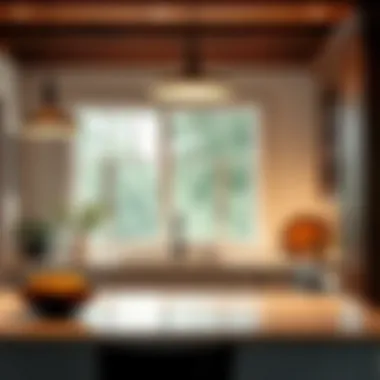
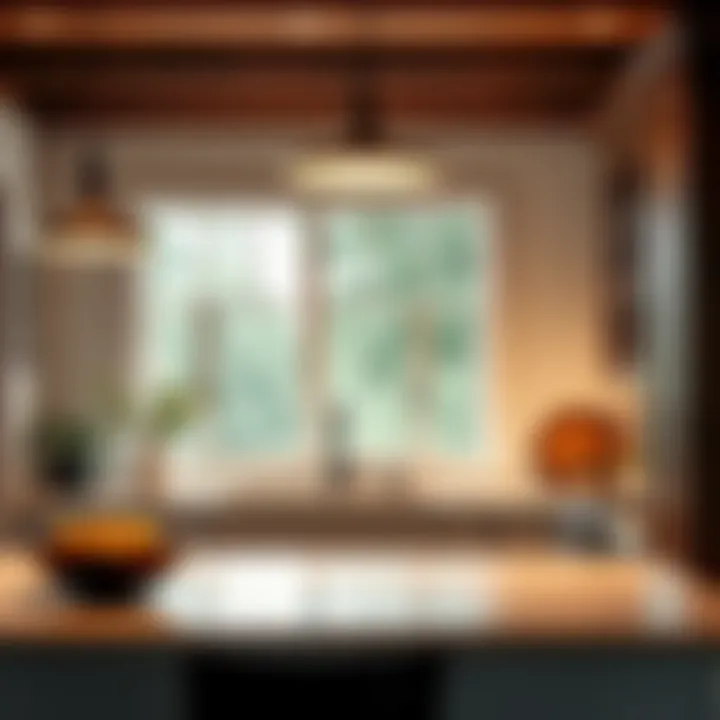
Dimming and Control Options
The ability to dim pendant lights and control them remotely adds yet another layer of sophistication. Dimming options can adjust the intensity of light, allowing for a seamless transition from bright daylight during cooking to softer, ambient light during a cozy dinner.
When it comes to choosing dimming solutions, homeowners can consider:
- Traditional Dimmer Switches: While these are not as advanced as smart options, they allow quick adjustments without needing special gadgets.
- Smart Dimmer Switches: Upgrading to smart dimmer switches can provide a hands-free approach. These devices can be programmed to change lighting levels at various times, or controlled through voice commands or smartphone apps.
- Remote Control Systems: Some high-end kitchen designs incorporate more complex systems that allow you to control multiple lighting elements from one location, giving you ultimate flexibility.
"Optimizing light control in your kitchen can shift the entire ambiance, making a significant difference in both functionality and mood."
Considering how you want the light to perform in your kitchen is crucial. Placement combined with control options can truly unlock the full potential of your kitchen’s pendant lighting, enhancing your culinary activities and overall experience in the space.
Equipping your kitchen with the latest technology doesn't just modernize your design; it transforms how you interact with the heart of your home. As we continue to embrace innovation in living spaces, the integration of smart and controllable lighting solutions will undoubtedly become a staple in kitchen design.
Trends in Kitchen Pendant Lighting
In today's world, kitchen pendant lighting transcends mere functionality. It's about blending aesthetic pleasure with practical use, capturing the essence of modern design and user preferences. As styles evolve and technology advances, understanding the latest trends in kitchen pendant lighting becomes crucial for anyone seeking to revamp their space or simply add a touch of modern flair. Homeowners, designers, and DIY enthusiasts alike stand to gain from keeping their fingers on the pulse of contemporary trends.
Sustainable and Eco-Friendly Options
The growing emphasis on sustainability and eco-conscious living increasingly influences kitchen design, including lighting solutions. Pendant lights today often embody a commitment to environmentally friendly materials and energy-efficient technology.
Many manufacturers are turning to recycled materials, such as reclaimed wood or repurposed metals. Such choices do not only minimize waste but also add unique character to each piece.
Energy-efficient bulbs are becoming the norm, with LED options shining brightly. They consume less power and last significantly longer than traditional incandescent bulbs. By swapping old bulbs for energy-efficient ones, you not only care for the planet but also trim energy costs, which brings a smile to the budget.
"Sustainable design isn’t just a trend; it’s a necessity for the future of our planet."
Consider brands like West Elm and Lumens that offer a variety of eco-friendly pendant light options. This shift towards sustainability enhances the overall appeal of your kitchen while aligning with conscious living principles.
Customization and Personalization
In a world where personalization reigns supreme, kitchen pendant lighting is no exception. Today's homeowners are looking for ways to express individuality through design choices. Instead of simply picking a fixture off the shelf, the opportunity to customize lighting has become a sought-after option.
From interchangeable shades to adjustable heights, customization can transform a standard pendant light into a statement piece that resonates with the homeowner’s aesthetic. Some companies even allow consumers to choose colors, materials, and designs that align with their vision.
This trend empowers owners to create a distinctive atmosphere. Whether you desire a sleek, modern vibe or a more rustic charm, tailored pendant lights can elevate any kitchen to new heights of design. Shades made of colorful glass or intricate patterns can breathe life into an otherwise understated kitchen.
Mixed Lighting Styles
Gone are the days of sticking strictly to one style. Today's trend in kitchen design embraces the beauty of mixed lighting styles. Homeowners are increasingly combining various lighting elements to enhance visual interest and create depth.
For instance, pairing industrial-style metal pendant lights with warm, soft fabric shades can create an inviting contrast that tells a story. This kind of mix not only showcases creativity but also allows for different zones within the kitchen to shine. It’s like creating a lighting buffet, where each fixture contributes its own flair without overshadowing others.
Here are a few combinations to consider:
- Glass and Metal: Combine sleek glass shades with metallic finishes for a fresh look.
- Vintage and Modern: Mix rustic, vintage fixtures with contemporary elements for an eclectic presence.
- Natural and Man-made: Incorporate wooden pendant lights alongside sleek, minimalist options to harness the warmth of nature.
As the landscape of kitchen pendant lighting continues to shift, it’s evident that these trends reflect more than just aesthetics. They represent a movement towards a more personalized, sustainable, and expressive kitchen environment. Understanding these trends can help homeowners make choices that not only illuminate their spaces but also elevate their overall design narrative.
Case Studies and Image Inspirations
The value of including case studies and image inspirations in any discussion of kitchen pendant lighting cannot be overstated. They serve as powerful tools that bridge theoretical knowledge and practical application, granting homeowners and designers alike a clearer understanding of how different styles and placements can elevate a kitchen space.
When one browses through actual examples, they can see firsthand how various pendant lights harmonize with different kitchen designs. This visual storytelling not only inspires creativity but also helps individuals make informed decisions based on real-world applications.
- Visual Impact: Pictures often convey emotions and effects that words alone can't capture. A stunning pendant light over a kitchen island can transform the entire atmosphere of the room, making it feel warm and inviting.
- Functional Insights: Case studies often highlight the balance between aesthetics and practicality. Seeing how lighting can illuminate work surfaces while also adding flair helps in planning.
- Diverse Perspectives: Different settings, from urban lofts to rustic farmhouses, showcase how versatile pendant lighting can be. Exploring these varied examples provides a broader palette of ideas for viewers.
"A well-chosen light fixture is like the cherry on top of a delicious dessert; it completes the look and draws the eye."
Incorporating images gives a visceral sense of scale, color, and context that written descriptions often fail to fully deliver. Understanding the nuances of size, shape, and installation will significantly benefit anyone considering upgrades or renovations. Also, each installation case carries lessons learned regarding placement and choice, enriching the overall knowledge base of the reader.
Residential Examples
Residential kitchens are often the heart of the home, and the right pendant lighting can significantly enhance both functionality and style. For example, a family in a suburban area opted for sleek, brushed nickel pendant lights above their island. The fixtures not only provided adequate task lighting for meal preparations but also added a modern touch to their otherwise classic decor. The pendant shapes were chosen to reflect the contour of their cabinetry.
- Design Cohesion: The homeowners ensured that their pendant lighting matched other fixtures in the area, creating a seamless look that adds a sense of unity.
- Height Choice: With these lights hung at an appropriate height, they achieved a cozy atmosphere without obstructing views across the kitchen space.
- Personal Touches: Decorative elements like colored bulbs or unique shapes helped the family project their own style into this essential space.
Each residential example is a testament to the transformative power of light, illuminating not just the kitchen but the daily lives that unfold within it.
Commercial Applications
In the commercial sector, the use of pendant lights can serve multiple purposes — enhancing the customer experience while ensuring functionality. A popular café chain recently redesigned its dining area and chose a mix of retro and modern pendant lights to create a casual yet chic atmosphere. This variety attracted not just food lovers but also design enthusiasts.
- Brand Identity: The light fixtures were selected to reflect the brand's ethos, providing an immediate visual cue for patrons on what to expect in terms of ambiance and dining experience.
- Efficiency: The chosen LED bulbs not only economically met lighting needs but also ensured longevity, thus reducing maintenance tasks for the busy staff.
- Flexibility: Pendant groups were arranged in clusters over communal tables, allowing for varied lighting levels depending on the time of day and type of event. This adaptability demonstrates the practical benefits of case study insights.
These commercial scenarios underscore how the right lighting solutions not only support the aesthetic goals of a space but also enhance operational efficiency. Combining these insights with careful planning will appeal to those looking to revamp their kitchens with lighting that does more than just shine.
Finale
In wrapping up our exploration of kitchen pendant lighting, it’s vital to grasp the significance of this often-overlooked aspect of kitchen design. This article has taken you through the various styles, materials, and placement strategies that can significantly impact not just the aesthetics but the functionality of your kitchen space.
A well-chosen pendant light can do more than illuminate a room; it can serve as a focal point, setting the tone for your entire kitchen. From the sleek, modern designs that complement contemporary spaces to the rustic charm of vintage-look fixtures, the right choice reflects personal style while catering to practical needs.
Moreover, considering factors such as color temperature and height placement can transform your kitchen from ordinary to extraordinary. When placed over islands or dining areas, pendant lights can create an inviting atmosphere, perfect for both cooking and gathering.
"Lighting is the soul of design; it breathes life into every corner."
In addition, understanding the nuances of installation and maintenance cannot be ignored. By ensuring that your kitchen pendant lights are well-maintained and appropriately installed, you not only enhance their longevity but also retain the brilliance they offer to your culinary haven.
Ultimately, as discussed in this article, choosing the right kitchen pendant lighting combines an artful blend of form and function. This synthesis empowers homeowners, designers, and DIY enthusiasts alike, striving to cultivate spaces that are not only functional but also visually stunning.
As you move forward, let the insights gathered here guide your choices, illuminating paths to captivating kitchen environments.
For further reading on lighting design principles, you can check this resource: Lighting Design, which delves into the broader implications of lighting in various settings.
